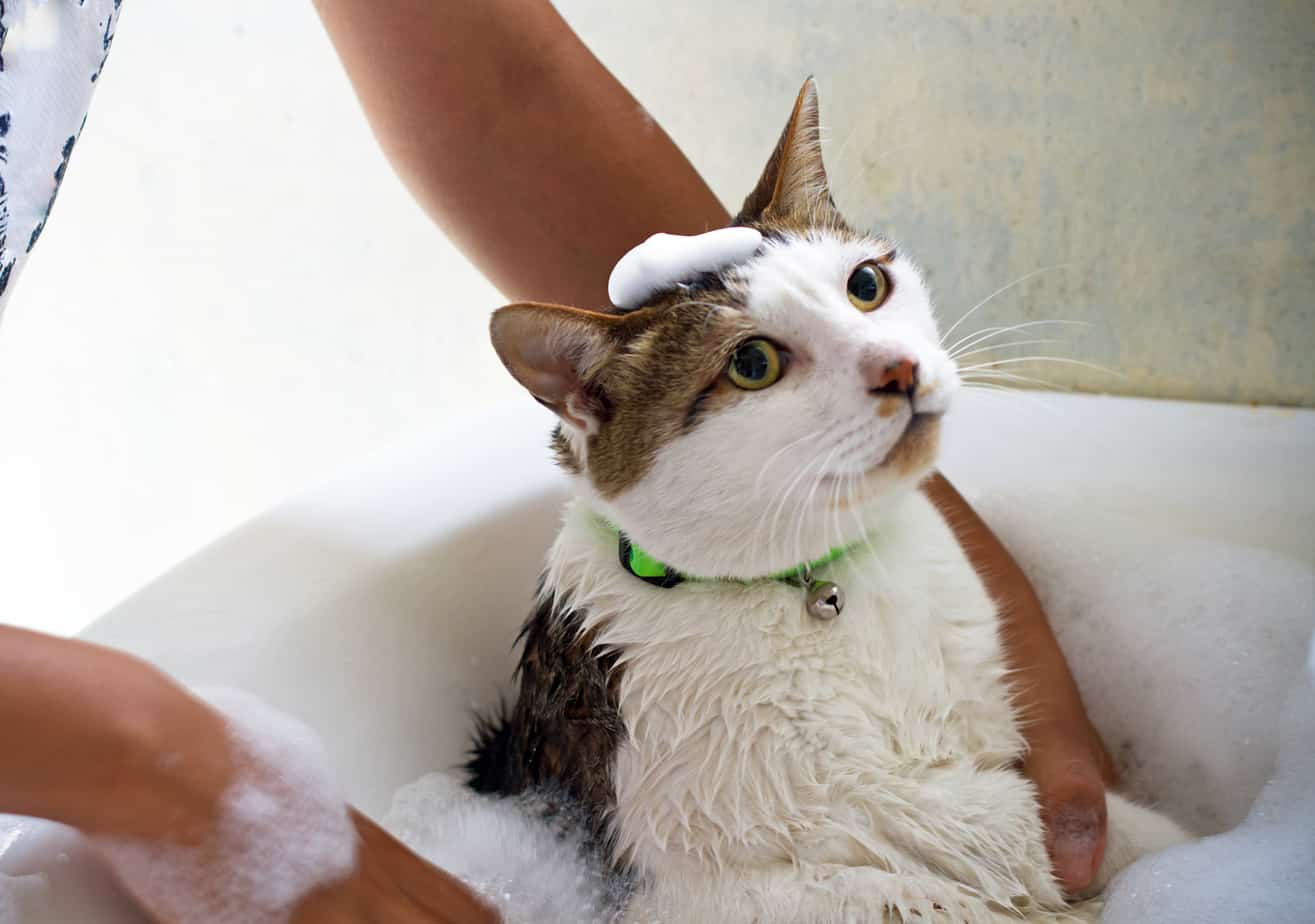Cats are known to be fastidious creatures, and as such, they spend a lot of time and dedication grooming themselves and keeping their fur clean. Dogs, on the other hand, need to be bathed regularly.
So, should you bathe your cat, and if so, how often?
Cats are generally capable of cleaning themselves. A cat’s tongue has a special cleaning mechanism, and its saliva contains a natural detergent-like substance. Therefore, cats don’t need to be bathed regularly, except when they can’t clean themselves. Limit cat-baths to once every 4 to 6 weeks.
Let’s dive in and see how often you should bathe your cat and how to make the process pleasant for both you and your cat.
Do cats need baths?
As a general rule, cats don’t usually need baths. They are natural groomers and keep themselves and their habitat clean. Often cats will avoid activities that will get them dirty. Exceptions are old, sick, or physically challenged cats.
And cats would agree with this because most cats hate water and will try to avoid a bath at all times.
But, as mentioned, there are exceptions.
Dogs enjoy rolling around in the dirt and muck. They couldn’t care less about how they look and smell, and keeping clean is not one of their top priorities.
On the other hand, cats are very clean by nature and want to keep a neutral body odor to help them in the hunt.
Healthy cats are more than capable of grooming themselves and keeping their fur as well as skin clean. Cats spend a considerable amount of their waking hours grooming themselves.
Cat tongues are a masterpiece of nature’s engineering and work specifically well in cleaning cat fur. A cat’s tongue contains many tiny spines that take the dirt out but not the hairs. It’s also perfect for transferring lots of saliva onto the cat’s body to help keep them cool.
Cats have been cleaning and grooming themselves for centuries. They haven’t needed much human help with that. Needless to say that, under normal circumstances, cats don’t need humans to bathe them.
What cats need help grooming and washing?
While most felines can and will keep themselves clean and presentable, there are some poor sods out there who need a bit of help in the personal care department.
- Obese/overweight cats – Cats that have a weight problem might not be able to reach all parts of their body.
- Sick or recovering cats – When your cat is sick, recovering from a medical treatment or surgery, they may need some help grooming themselves.
- Old cats – Cats in their Golden years might not be as flexible as they once were. Because of this, they might have trouble reaching all nooks and crannies.
- Neglected or stray cats – Some cats have not received the care they need or may have lived on the street for a while. Sometimes they lose their will and ability to groom themselves. Especially in bad cases of flea infestations, these kitties might need a good bath to fix them up.
Apart from these, all other cats who need an extra bit of TLC can also have their baths.
To be clear, there are no reasons not to bathe your cat. According to the National Cat Groomers of America bathing your cat every 4 to 6 weeks if necessary is perfectly fine.
As long as you follow the guidelines below, it should be a good experience for both of you.
Do’s and Don’t while bathing a cat
DON’T bathe too frequently
Bathing a cat too frequently, especially with soap or shampoo, can cause skin irritation, dry skin, dandruff, or rashes. Too much washing may also cause an imbalance in the natural oils in your pet’s skin. This can diminish the skin’s natural ability to fight off infections or bacteria. As a rule of thumb, stick to once every 4 to 6 weeks to give your cat’s skin time to recover.
DO stick to a regular bathing schedule
Once you start bathing your cat, it’s best to stick to a regular schedule. First of all, this helps to get your cat used to being washed. If she’s not fond of it, a regular schedule will help her get used to it over time. Secondly, if your cat has sensitive skin, having fixed times between baths will help the skin recover. How often should you bathe your cat? Try to stick to once every 4 to 6 weeks.
DO use pet approved soap and shampoos
It might be tempting to use a cleansing product you already have, but we urge you to use products specifically meant for cats. Human shampoo, even baby shampoo, has not had the right pH level for your cat’s sensitive skin and can cause problems. Also, do not mix products for different pets. Cat shampoo is for cats, dog shampoo for dogs, and so on.
By all means, do not use dawn or any other dishwashing detergent! These products are not meant for cleaning pets (or humans) and sometimes contain harmful chemicals. Yes, they are great to get rid of fleas but stick to approved cat shampoos and soaps.
DON’T use a tub
A pressure nozzle from a hose or showerhead is necessary to bathe your pet properly. So is an area where the water can drain as you wash. It may seem cozy and warm to keep your pet in a certain depth of water throughout their bath. However, a tub half-filled with water will keep the soap stuck in their fur. This could cause dry skin, itchiness, and matting.
DO pay close attention to your pet
If your pet is getting smelly in between baths and seems to need a cleaning more often, there might be another reason why they’re smelly. Skin infections, ear infections, or dental problems may cause smell as well. In those cases, an extra bath will not help and might even exacerbate the problem. Consult with your vet if you suspect something is wrong or when your cat is having an allergic reaction to the cleansing products.
DON’T use hair dryers designed for humans
After bathing your cat, you might be tempted to get them dry and warm as quickly as possible and use your hairdryer. Don’t! The dry heat from the hairdryer may cause itchy and dry skin, or it may burn the sensitive skin of your cat. Instead, gently dry them with a towel and allow them to air-dry indoors to avoid them from getting the chills.
DO clip your cat’s nails before bath time
It’s not a secret that cats and water don’t mix well. Although cats will get used to their regular bath after a while, it’s a good idea to clip their nails before bathing to avoid them scratching you. Use a special feline nail clipper to avoid breaking, splitting, or damaging your cat’s nails.
DO prepare yourself for a workout
It’s about as easy to bathe a pet as it is to bathe a child, which is to say, not all that easy. A good lathering up of your pet can require some serious muscle on your part, especially if your pet is not a fan of getting clean. Maintaining a routine can help your pet accept the inevitable and require less wrestling on your part.
DO combine brushing with bathing
Some pets make it difficult to brush their teeth, but it’s important to make an effort to carry out this important task as often as possible. Dental disease is the most common health problem among pets. Good dental care for your cat is strongly recommended. Thorough brushing and plaque removal helps to keep their “cat breath” refreshing.
Bathing your cat – step by step
The American Society for the Prevention of Cruelty to Animals (ASPCA) recommends following these steps to make bath time for your kitty less stressful (for you and them):
- Bathe your cat when they are mellow- tire them out with a play session beforehand
- Trim your cat’s nails before bathing (see PetFirst Pet Insurance’s video on how to trim your cat’s nails)
- Brush your cat to remove any loose hair or mats
- Place cotton in your cat’s ears to keep water out.
- Use a rubber mat in the sink or tub to keep your cat from slipping.
- Use a hand-help sprayer to wet your pet – do not spray directly in the cat’s ears, eyes, or nose.
- Massage a solution of 1 part cat shampoo to 5 parts water – work from head to tail and avoid the face, ears, and eyes
- Rinse your cat thoroughly with lukewarm water – make sure all soap residue has been removed
- Use a washcloth to wipe your pet’s face with water (or a more diluted solution of shampoo)
- Wrap your kitty in a large towel and dry her within a warm place – untangle her fur with a wide-tooth comb
- Praise your cat and reward them with a special treat for a successful bath.
Bathing a cat can be hard, especially for the first couple of times. When your cat gets used to it, and you treat them carefully, with respect, and with love, they will understand you are trying to care for them. They will show you in their own cat-ways that your cat loves you back.




